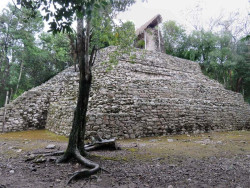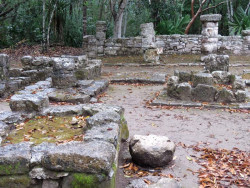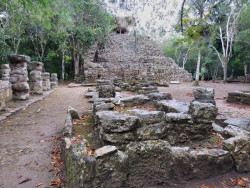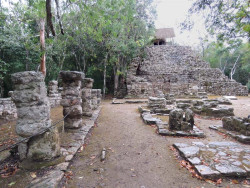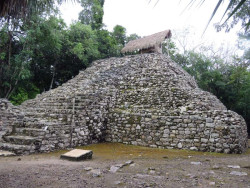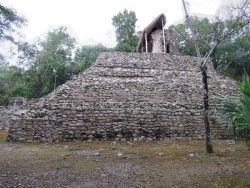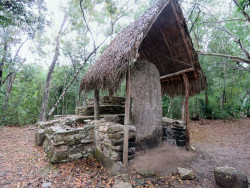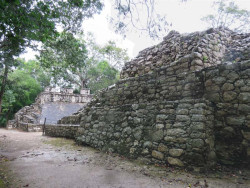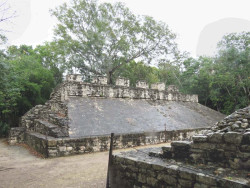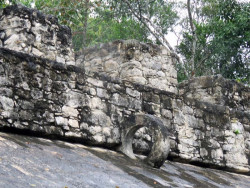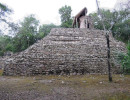- You are here:
- Home
- Man-made
- Archeological Sites
- Coba in Mexico
Coba in Mexico
Rainy morning at the Pre-Columbia Mayan site of Coba in Mexico
Coba is an ancient Maya city on the Yucatán Peninsula, located in the Mexican state of Quintana Roo. As part of the largest network of stone causeways of the ancient Maya world, Coba contains many engraved and sculpted stelae that document ceremonial life and important events of the Late Classic Period (AD 600–900) of Mesoamerican civilization. The ruins of Coba lie 29 miles northwest of Tulum, also in the State of Quintana Roo. Located around two lagoons, Lake Coba and Lake Macanxoc, a series of elevated stone and plaster roads radiate from the central site to various smaller sites in the area. These roads are known by the Maya as "sacbe" or white road. Coba contains a group of large temple pyramids known as the Nohoch Mul, the tallest, Ixmoja, is 138 ft. in height.
Coba was estimated to have had 50,000 inhabitants with a sizable agricultural population at its peak of civilization, and its built-up area extends over 50 square miles. The bulk of Coba's major construction seems to have been made in the middle and late Classic period, about 500 to 900 AD, with most of the dated hieroglyphic inscriptions from the 7th century. However, Coba remained an important site in the Post-Classic era, and new temples were built and old ones were kept in repair until at least the 14th century, possibly as late as the arrival of the Spanish.
Sacbes, or raised pathways, lined with stones and filled with smaller stones, sand, shell, and/or plaster on top are very common at Coba. These paths were the connecting links to most areas of Coba. Although the Mayans used wheels in artifacts such as toys, anthropologists note that they did not implement the wheel for the transportation of goods or people.
Archaeological evidence indicates that Cobá was first settled between 50 BC and 100 AD. At that time, there was a town with buildings of wood and palm fronds built on flat platforms. The only archaeological evidence of that time is fragments of pottery. After 100 AD, however, the area around Coba experienced strong population growth and an increase in its social and political status among Maya city states which would ultimately make Coba one of the biggest and most powerful city-states in the northern Yucatán area. Between 201 and 601 AD, Coba dominated a vast area, including the north of Quintana Roo and areas to the east. This power resided in its control of large swaths of farmland, control over trading routes, and most importantly, control over ample water resources.
The people of Coba had traded extensively with other Mayan communities, particularly the ones further south along the Caribbean coast in what is now Belize and Honduras. It utilized the ports of Xcaret, Xel-Há, Tankah, Muyil, and Tulum. Items of trade of this area were: salt, fish, squash, yams, corn, honey, beans, turkey, vegetables, chocolate drinks, and raw materials such as limestone, marble, and jade. Almost all of the commerce was controlled by wealthy merchants using cacao beans for currency.
Coba maintained its influence by establishing military alliances and arranging marriages among its elites. Coba shows traces of Teotihuacan architecture, which would attest to the existence of contacts with the central Mexican cultures. Stelae uncovered at Coba are believed to document that Coba had many women as rulers.
After 600 AD, the emergence of powerful city-states of the Puuc culture and the emergence of Chichén Itzá altered the political spectrum in the Yucatán peninsula and began eroding the dominance of Coba. Beginning around 900 or 1000 AD, Coba must have begun a lengthy power struggle with Chichén Itzá, with the latter dominating at the end as it gained control of key cities such as Yaxuná. After 1000 AD, Coba lost much of its political weight among city-states, although it maintained some symbolic and religious importance. This allowed it to maintain or recover some status, which is evidenced by the new buildings dating to 1200-1500 AD, built in the typical Eastern coastal style. However, power centers and trading routes had moved to the coast, forcing cities like Coba into secondary status. Coba was abandoned by the time the Spanish conquered the peninsula around 1550.
The first mention of Coba in print was by John Lloyd Stephens when he mentioned hearing reports of the site in 1842 from the priest of Chemax. It was so distant from any known modern road or village that he decided the difficulty to get there was too daunting and returned to his principal target of exploring Tulum instead. For much of the rest of the 19th century the area could not be visited by outsiders due to the Caste War of Yucatán, the notable exception was Juan Peón Contreras who was then director of the Museum of Yucatán. He made the arduous journey in September 1882 and is now remembered by the four naive pen-and-ink sketches that he made of the ruins.
Amateur explorer and author of popular books on Maya culture, Dr. Thomas Gann was brought to the site by local Maya hunters in February 1926. Gann published his first-hand description of the ruins later the same year. Dr. Gann gave a short description to the archeologists of the Carnegie Institution of Washington project at Chichen Itza, of the large mounds he had sighted, but not visited for lack of time, lying to the northeast of the main group.
Coba remained little visited due to its remoteness until the first modern road to Coba was opened in the early 1970s. With a major resort planned for Cancún, it was realized that clearing and restoring some of the large sites could make it an important tourist attraction. The Mexican National Institute of Anthropology & History began some archeological excavations in 1972 and consolidated a couple of buildings. Expectations of new discoveries came to light, and in the same year, much of Grupo Coba was cleared and not even its tall ramón trees were spared.
In 1975 a branch road from the asphalted highway being built from Tulum to Nuevo X-Can reached Coba. Then at the start of the 1980s, another road to Coba was opened and a regular bus service began. Coba became a tourist destination shortly thereafter, with many visitors flocking to the site on day trips from Cancún and the Riviera Maya, even though only a small portion of the site has been cleared from the jungle and restored by archaeologists.
Cut out of the dense jungle, Cobá lies in the tropics, subject to alternating wet and dry seasons. At Cobá, however, rain can occur at almost any time of the year, but there is a short dry period in February and March and a heavy concentration of rain from September through November. As of 2005 the resident population of Coba was 1,167 and grew to 1,278 by the 2010 census. On the other hand, Coba received 702,749 visitors in 2017. One of Coba's main attractions was the Ancient Pyramid which, unlike Chichen Itza's Kukulkan Pyramid, climbing its 130 steps to the top of the Pyramid was allowed. But by 2020, climbing the pyramid was no longer permitted.
Photographed in 2024.

















































